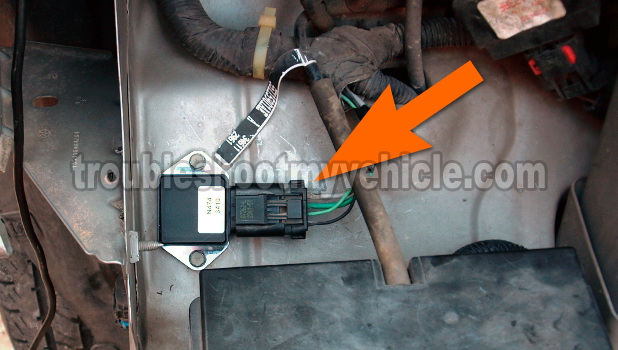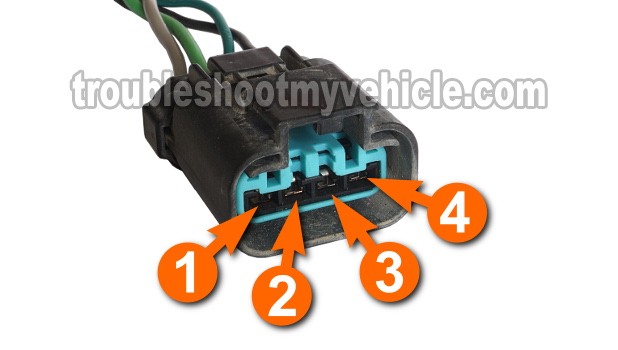
This tutorial will help you to diagnose the Pulse Width Modulated (PWM) fan relay on the 1999-2003 Jeep 4.0L Grand Cherokee SUVs and/or the codes P1491 (radiator Fan Control Relay Circuit).
The dealer, at the time of this writing, will charge you $95 (US) to diagnose it. But if you have more time than money, you can easily diagnose it yourself, and I'll show you how.
Testing the fan relay is easy, the hardest part is getting to it, since Jeep in all its wisdom, located the fan relay behind the right side (passenger side) of the front bumper and you'll probably have to remove it to access it.
You can pay Jeep an arm and a leg to do it, or you can, with my help, diagnose and repair the issue yourself, save that money and spend it on something like tools.
Contents of this tutorial:
ES ![]() You can find this tutorial in Spanish here: Cómo Probar El Relé PWM del Ventilador (4.0L Jeep) (at: autotecnico-online.com).
You can find this tutorial in Spanish here: Cómo Probar El Relé PWM del Ventilador (4.0L Jeep) (at: autotecnico-online.com).
APPLIES TO: This tutorial applies to the following vehicles:
- 1999, 2000, 2001, 2002, 2003 4.0L Jeep Grand Cherokee.
RELATED WIRING DIAGRAM:
Important Tips
TIP 1: The way I've designed the Jeep PWM fan relay test, you'll need a scan tool that can read live data (not a code reader), since you'll need to keep an eye on the engine's coolant temperature with it.
You do not need the Jeep factory scan tool, just a generic scan tool that you can buy at your local auto parts store or online and a multimeter. Now depending on your level of 'wrenching experience', you can modify this test so that you can do it without a generic scan tool (and I leave this up to you).
TIP 2: It's very important that you start out with a cold engine. If you have a scan tool, verify that the engine coolant temperature (ECT) value is under 190° F. If the engine has been running for an extended period of time, let it cool down for about 1 hour or more.
TIP 3: Before you jump into the tests, take a look at and read the entire article so that you'll know what the test is all about and what you'll need to do.
TIP 4: The very first thing that you need to test/verify, is the fan. You need to physically see it come on by directly applying 12 Volts to it and if the fan motor does come on, calculating its amperage draw (and I'll show you how).
TIP 5: Also, you're not gonna' find any 'remove and replace' type instructions since the article is all about the diagnosing the relay, not how to remove and replace it. So you may have to buy a repair manual or do further research online.
Symptoms Of A Bad PWM Fan Relay
The most obvious symptom of a bad PWM fan relay is that your Jeep is gonna' overheat.
You'll also see one or all of the following symptoms as the engine overheats:
- The electric radiator fan motor does not come on.
- Coolant bubbling out of the coolant reservoir.
- Temperature gauge on the instrument cluster is maxing out.
- Check engine light (CEL) is on and:
- DTC P1491 stored in the computer's memory
If your Jeep overheats beyond a certain point, you risk blowing the head gasket and/or cracking the cylinder head.
Thankfully, testing the PWM fan relay can be easily done right at home, without the need of taking it to the Jeep house.
TEST 1: Checking For Power

IMPORTANT: Before you start this test, on your 1999-2004 Jeep Grand Cherokee, you need to have calculated the amperage the fan motor is consuming. This is very important.
So if you haven't, you can find the out how to do this here: TEST 4: Calculating The Amperage Draw Of The Fan Motor and Real Life Case Study. Once you've calculated the amperage draw (and it's within specification), come back to this test step.
OK, to get this show on the road, the first thing you'll do is to make sure the PWM fan relay is getting power.
These are the test steps:
- 1
Disconnect the PWM fan relay from its electrical connector.
- 2
Grab your multimeter and select Volts DC mode on it.
- 3
Probe the gray (GRY) wire labeled by the number 1 (in the photo above) with the red multimeter test lead.
What I recommend you do is to use a back-probe on the connector or a wire piercing probe on the wire. If you probe the front of the connector, do it very gently and with the appropriate size probe to avoid damaging the female terminal.
NOTE: To access the PWM fan relay, you'll need to remove the front bumper. - 4
Connect the black multimeter test lead on the battery negative (-) terminal.
- 5
Your multimeter should register 10 to 12 Volts since the GRY wire is always hot.
OK, let's interpret your test results:
CASE 1: Your multimeter registered 10 to 12 Volts. This confirms that the fuse that supplies the PWM fan relay with power is not blown. You can proceed to the next test, go to: TEST 2: Checking For Ground.
CASE 2: Your multimeter DID NOT register 10 to 12 Volts. This confirms that the fuse that supplies the PWM fan relay is blown. Replace the fuse and retest.
This fuse is found in the fuse box in the engine compartment.
TEST 2: Checking For Ground

In FAN RELAY TEST 1, you verified that the Pulse Width Modulated (PWM) Relay is getting power in the form of 12 Volts DC. In this test step, you're gonna' verify that the relay has a good Ground.
The wire that feeds Ground to the PWM fan relay is the black (BLK) wire labeled with the number 4 in the photo above.
We'll do a simple multimeter voltage test to test for the presence of Ground.
This is what you'll need to do:
- 1
Disconnect the PWM fan relay from its electrical connector.
- 2
Set your multimeter to Volts mode.
- 3
Probe the black (BLK) wire of the connector with the black multimeter test lead.
This is the wire connects to the female terminal labeled with the number 4 in the photo above.
Use a back-probe on the connector or a wire piercing probe on the wire. If you probe the front of the connector, do it very gently and with the appropriate size probe to avoid damaging the female terminal. - 4
Connect the red multimeter test lead on the battery positive (+) terminal.
- 5
Your multimeter should read 10 to 12 Volts if Ground is present in the wire.
OK, now that the testing part is done, let's take a look at what your results mean:
CASE 1: Your multimeter registered 10 to 12 Volts. This means that the PWM fan relay has a good path to Ground.
So far you have verified that the PWM Relay is receiving power and Ground, the next step is to test that your Jeep's fuel injection computer (technically known as the Powertrain Control Module= PCM) is actually activating the Pulse Width Modulated (PWM) fan relay.
This test will let you know if the PWM fan relay is OK or fried. Go to: TEST 3: Checking For The Fan Relay Control Signal.
CASE 2: Your multimeter DID NOT register 10 to 12 Volts. This test result indicates that the PWM fan relay does not have a good path to Ground.
This is very unusual, what I suggest you do is to splice a wire into this circuit which you should connect directly on the battery negative (-) terminal (without cutting it) and retest.
TEST 3: Checking For The Fan Relay Control Signal

Confirming that the Pulse Width Modulated (PWM) fan relay is receiving the activation signal (to activate the fan) from the PCM (Powertrain Control Module=Fuel Injection Computer) or not, will help you to confirm that the fan relay is good or bad.
You'll need a multimeter, a generic scan tool, a portable house fan, and an automotive 12 Volt test light for this test.
OK, here are the test steps:
- 1
Set your multimeter in Volts DC mode.
- 2
Connect the black multimeter test lead to the wire labeled with the number 3 in the photo above.
IMPORTANT: The PWM fan relay must remain connected to its connector, use an appropriate tool (like a back-probe or a wire piercing probe) to probe the light green (LT GRN) wire. - 3
Connect the red multimeter test lead to the battery positive (+) post.
- 4
Disconnect the fan motor from its electrical connector.
- 5
Now connect the metal probe of 12 Volt test light to green (GRN) wire labeled with the number 2 (see photo).
- 6
Connect the alligator clip of the 12 Volt test light to the battery negative (-) terminal.
If the AC Works:
- 7
Make sure that the AC is turned off and then start the Grand Cherokee.
- 8
Your multimeter should read 0 Volts and the test light should be off with the AC off and the engine running.
- 9
Now, turn on the AC and look/listen for the AC compressor to come on.
- 10
Your multimeter should read 10 to 12 Volts and the test light should come on when the AC compressor runs.
- 11
Turn off the engine and go down to the test interpretations at the end of these test steps (no further testing is required).
If the AC DOES NOT Work:
- 7
Connect your scan tool to the OBD connector inside your Jeep Grand Cherokee and select the Live Data function on it, so that you can see the engine coolant temperature reading in degrees Fahrenheit (or degrees Celsius).
- 8
Start the engine and let it warm up
While the engine is warming up, you need to keep your eyes glued on the scan tool and the multimeter. On the scan tool, you need to see what the engine coolant temperature is. - 9
Your multimeter should register 0 Volts DC and the test light should be off at any temperature around 190° F or less.
- 10
At any temperature around 200 to 215° F, your multimeter should read 5 Volts DC.
There's a good chance that your multimeter may read 5 Volts for a few seconds and then register 0 Volts and then register 5 Volts again, this is normal. - 11
Once the temperature of the engine coolant temperature sensor (on the scan tool) reaches 217° F, your multimeter should register 12 to 13 Volts DC and the test light should be fully lit.
IMPORTANT: Do not let your Jeep Grand Cherokee's temperature go beyond 220° F. - 12
Turn off the engine and place the portable house fan on top of the engine. Turn on the fan and let it cool the engine down.
Alright, let's find out what your test results mean:
CASE 1: The multimeter registered 12 Volts and the 12 Volt test light DID NOT come on. This confirms that the PWM is fried and that it will need to be replaced.
Here's why: The 12 Volts your multimeter registered indicate that the PCM is activating the PWM fan relay. The fact that the test light did not light up means that the PWM fan relay is unable to process the PCM's activation signal because it's fried.
CASE 2: The multimeter did not register the indicated voltage. Recheck all of your multimeter connections and retest.
If the multimeter doesn't register the indicated voltages, then you have eliminated the PWM fan relay as the cause of the issue, since without the activation signal from the PCM, the PWM fan relay will not activate the fan motor.
It's beyond the scope of this article to find out why the PCM is not activating the PWM fan relay, but you have at least eliminated it as the cause of the P1491 code or overheating problem.
CASE 3: The multimeter registered 12 Volts and the 12 Volt test light did come on. This is the correct test result and it confirms two things:
- The PCM is activating the PWM fan relay.
- The PWM fan relay is activating the fan motor.
TEST 4: Calculating The Amperage Draw Of The Fan Motor
It's not enough to apply 12 Volts to the fan on your Jeep Grand Cherokee to see if the fan comes on or not (to conclude that it's good or bad).
Why? Because the fan could come on and lead you to believe that the fan motor is OK, but in reality, the fan motor is drawing too much amperage!
If the fan motor is using way too much amperage, the end result is that the Pulse Width Modulated (PWM) fan relay you just bought (or are gonna' buy) is gonna' fry (again).
And you'll be back to square one and thinking you misdiagnosed the overheating problem. Now, you would think that this over-amp condition would blow the fan motor fuse but this rarely happens.
We can easily check the amperage draw of the fan motor using Ohms Law. It simply involves measuring the fan motor's resistance and then, using this value, calculate how much amperage the fan motor is pulling (Amps=Volts ÷ Ohms).
Now, don't worry, if you're starting to think this is too complicated. I'm gonna' show you how easy this is and how to do it in the following test steps:
- 1
Disconnect the fan motor from its electrical connector.
- 2
Set your multimeter to Ohms mode.
- 3
Measure the fan motor's resistance by probing its two terminal with the multimeter test leads.
NOTE: It's important that the fan blades do not turn while you're resistance testing the fan motor. - 4
Write the Ohms value down on a piece of paper once the Ohms reading on your multimeter stabilizes.
- 5
Divide 12.5 by your resistance value.
The result of this calculation is the amount of amperage the fan motor is using.
To be a little more specific: Let's say that the resistance reading was 0.4 Ohms. This is what the math would look like: 12.5 ÷ 0.4 = 31.25 and this would translate to 31.25 amps. If you would like a little more detailed explanation about this, go to: Real Life Case Study in the next section.
Alright, let's find out what your test results mean:
CASE 1: Your test result resulted in a calculation of under 40 amps. This tells you that the fan motor is OK and will not fry the new PWM fan relay when you replace it (if applicable).
The next step is to check the Pulse Width Modulated (PWM) fan relay (if you haven't done so yet), go to: TEST 1: Checking For Power.
CASE 2: Your test result resulted in a calculation of an amperage over 40 amps. This indicates that the fan motor is bad and will fry the new PWM fan relay.
The next step is to check the Pulse Width Modulated (PWM) fan relay (if you haven't done so yet), go to: TEST 1: Checking For Power.
Real Life Case Study
To help you better understand how to test for the amperage draw of the fan motor, let me tell you what happened to a friend's Jeep Grand Cherokee.
He had installed a brand new fan motor and a brand new PWM fan relay (at the same time). About an hour later, the fan motor stopped working and the Jeep started to overheat once again. This is when he called me and I came over to check the Jeep.
I instinctively knew that the fan probably was using too much juice (even tho' it was a brand new one) and this is what I did, when I went over, to help him troubleshoot the problem:
- I tested the resistance of the fan motor, with the multimeter in Ohms mode and I got 0.2 Ohms for the result.
- I then divided 12.5 Volts (which is the battery voltage) by the fan motor's resistance value. This is what my math looked like:
- 12.5 ÷ 0.2 = 62.5 Amps (Ohms law: Amperage = Voltage ÷ Resistance).
This calculation told me that the fan motor (that my buddy had just replaced) on this 02 Grand Cherokee was using 62.5 amps and this is way over the 40 amp limit of the fuse (that protects this PWM fan relay and fan motor circuits).
To make the long story short, the new fan motor fried the PWM fan relay because it was defective and started to use way too much amperage. Yet the 40 amp mega fuse did not blow.
He replaced both again (this time with name brand aftermarket parts) and the problem was solved.
You DO NOT need to test the amperage draw while the fan motor is in action (for example: using an ammeter). Using Ohms Law (Ohms law: Amperage = Voltage ÷ Resistance) to figure out the amperage draw is very, very accurate.
You can avoid frying the new PWM fan relay (in case the fan is over the hill and about to croak) simply by figuring out the amperage usage of the fan motor before replacing the PWM fan relay with a new one.
If the amperage draw is greater than 40 amps, the fan motor needs to be replaced (even if fan motor comes on when you apply 12 Volts directly to it).
Hopefully this information helped! Return to TEST 4: Calculating The Amperage Draw Of The Fan Motor.

If this info saved the day, buy me a beer!


